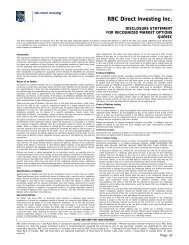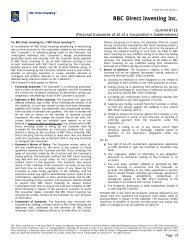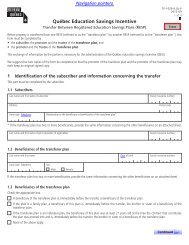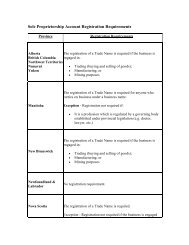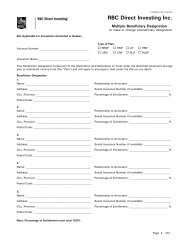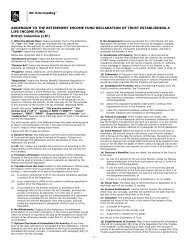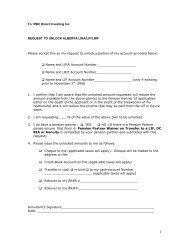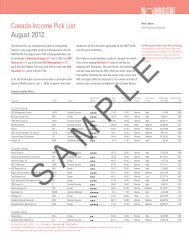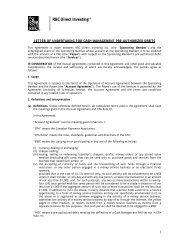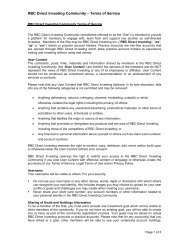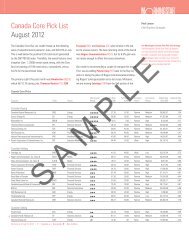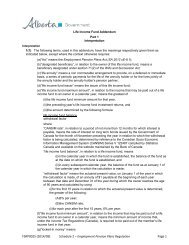View Sample PDF - RBC Direct Investing
View Sample PDF - RBC Direct Investing
View Sample PDF - RBC Direct Investing
Create successful ePaper yourself
Turn your PDF publications into a flip-book with our unique Google optimized e-Paper software.
Regional outlook – Asia • Yoji Takeda<br />
seems low, as the government’s deep<br />
pockets mean it is likely equipped<br />
to deal with either situation. Stock<br />
valuations are still below the historical<br />
average, and some moderate upside<br />
is expected as policy support builds<br />
confidence for sustained growth in<br />
the economy.<br />
Japanese markets caught up with<br />
their U.S. and Asian peers during the<br />
first quarter of this year, thanks to<br />
the Bank of Japan’s surprising step to<br />
ease monetary policy and the positive<br />
effect on exports of a weakening yen.<br />
However, the market continues to<br />
display a tendency to move with the<br />
yen and gave back a large portion of<br />
its recent gains when the currency<br />
strengthened. Corporate earnings in<br />
fiscal 2011 fell by about one-third due<br />
to the March 2011 earthquake and<br />
subsequent rise in the yen, as well<br />
as floods in Thailand and weakening<br />
global demand. Earnings in fiscal 2012<br />
should snap back, with gains expected<br />
in both the current fiscal year and the<br />
next one. During the tough environment<br />
in place since the financial crisis,<br />
Japanese corporations have made<br />
significant progress in reducing costs to<br />
counter much lower yen-denominated<br />
revenues, supply-chain problems<br />
and higher raw-material costs. The<br />
lower cost base will boost profits as<br />
revenues normalize this year, resulting<br />
in stronger cash flows on top of already<br />
high cash balances. This will likely<br />
result in dividend hikes and increased<br />
share buybacks. With the support<br />
of a strong recovery in earnings, we<br />
anticipate modest gains in the second<br />
half of 2012, although the market will<br />
continue to be affected by currency<br />
shifts and global risk appetites.<br />
In addition, political turmoil could<br />
overshadow higher profits in the near<br />
term, as the government of Yoshihiko<br />
Noda may have to contest late-summer<br />
elections for the lower house of<br />
Parliament.<br />
With the global economy slowing,<br />
stock markets in both South Korea<br />
and Taiwan have failed to regain<br />
levels reached before the market<br />
downdraft that started in August 2011.<br />
That said, valuations are not deeply<br />
discounted. Moderate upside can<br />
be expected in the near term as long<br />
as export demand from China picks<br />
up and/or earnings from companies<br />
with a domestic focus improve with<br />
policy easing. The economies of both<br />
countries continue to benefit from<br />
robust overseas demand for high-end<br />
electronics such as smartphones and<br />
tablets. South Korea also enjoys strong<br />
auto-related exports, particularly to the<br />
U.S. On the flipside, domestic sectors<br />
and exporters of flat-panel displays<br />
and computers remain weak in both<br />
countries. Raw-material exports such<br />
as chemicals and steel products are<br />
also weaker. Inflationary pressures<br />
are easing and there is room for some<br />
monetary stimulus, as government-set<br />
interest rates in both countries have<br />
not been cut since they started rising<br />
in 2010. There are some policy risks,<br />
however. In South Korea, elections set<br />
for December suggest that economic<br />
policy will favour social welfare over<br />
the interests of the “chaebol” industrial<br />
groups that dominate the economy. In<br />
Taiwan, the government is preparing<br />
to introduce a capital-gains tax on<br />
equity investments starting next year,<br />
so any meaningful market gains will<br />
have to wait until better global demand<br />
produces a recovery in exports.<br />
The Australian market has performed<br />
in line with its peers so far this year,<br />
but with less volatility. The market is<br />
supported by high dividend yields,<br />
which are somewhat offset by recent<br />
weakness in the Australian dollar. The<br />
economy continues to diverge, with<br />
a strong mining sector contrasted<br />
with weak domestic sectors. But with<br />
Chinese demand growth moderating,<br />
even mining investments are likely to<br />
be hurt. Weak domestic growth and<br />
relatively benign inflation prompted<br />
the Reserve Bank of Australia to cut<br />
its benchmark interest rate in early<br />
May by a more-than-expected 0.5%,<br />
pushing the currency below parity<br />
with the U.S. dollar. Monetary easing<br />
is likely to continue to ensure the<br />
economy remains healthy. Although<br />
we do not expect much downside,<br />
equity valuations are closer to more<br />
normal ranges, and profit growth will be<br />
needed to justify higher P/E multiples.<br />
SAMPLE<br />
The global investment outlook <strong>RBC</strong> INVESTMENT Strategy coMMITTEE Summer 2012 I 61



